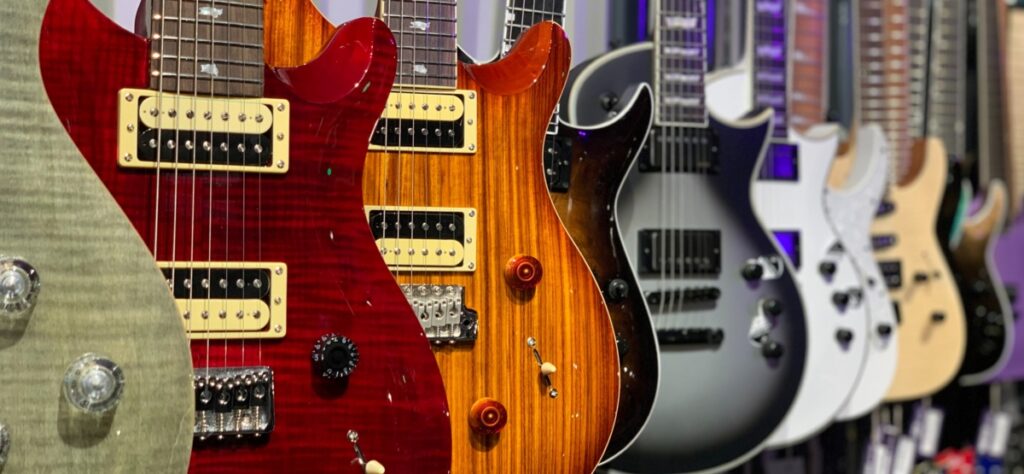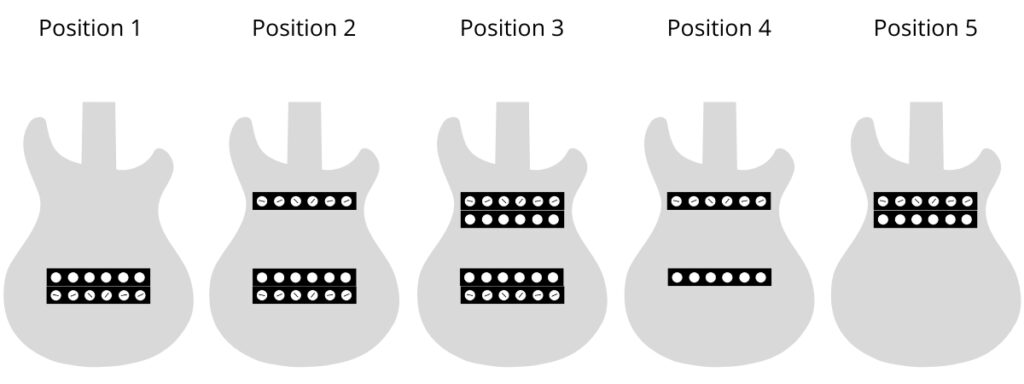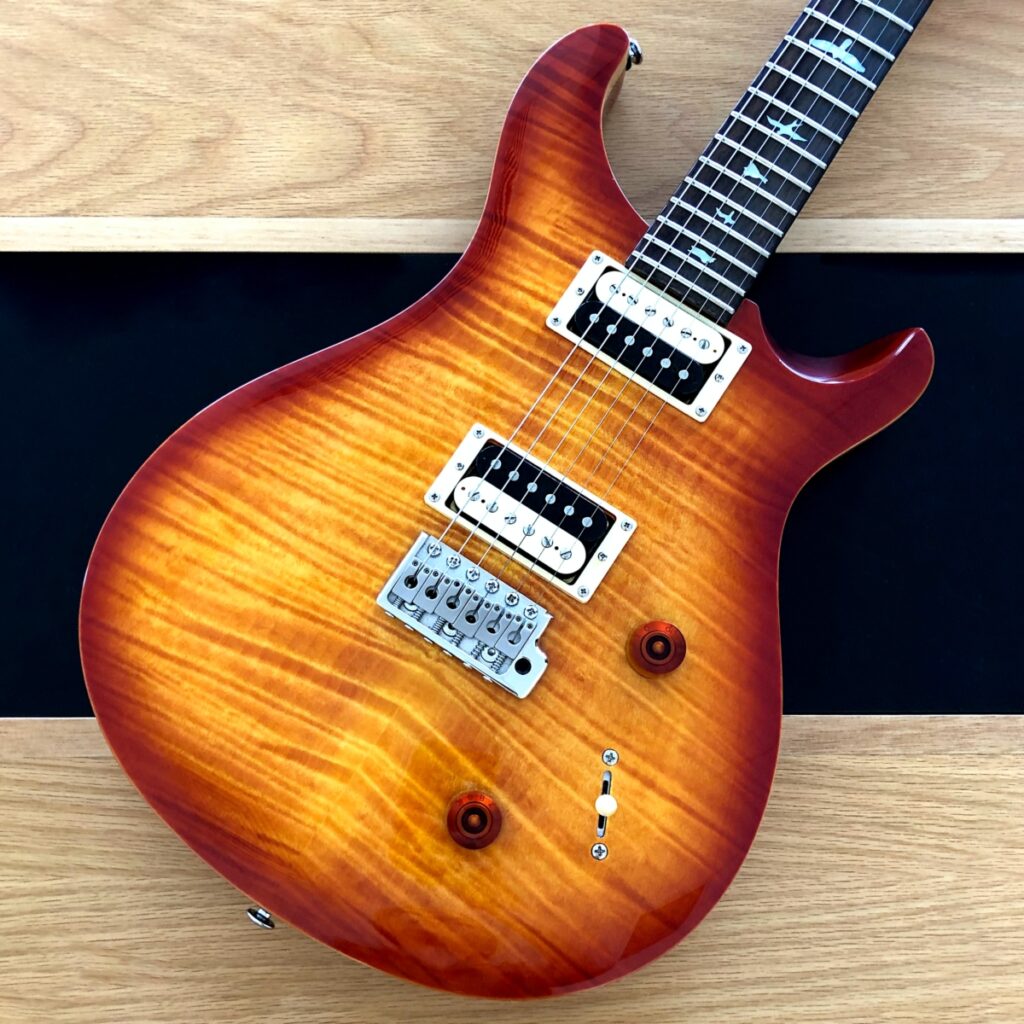PRS make a wide-range of mid-priced and very premium guitars. The SE line is one of the most popular in the PRS line-up, but what makes it different from the standard PRS line? In this article, I’ll be comparing the PRS and PRS SE range in detail so you can decide on the best guitar for you.
The Quick Answer
PRS guitars are more expensive compared to PRS SE guitars. PRS guitars are made in America and have more premium finishes, and use higher quality materials compared to the SE line which is made in Indonesia, South Korea and China. The Core-PRS line sounds darker and fuller compared to the SE line.
Comparing Specifications
First, let’s take a look at the main specification differences between the SE and standard PRS lines. For simplicity, I’ll compare the Custom 24 versions in the table below.
| Feature | PRS Custom 24 | PRS SE Custom 24 |
| Top | Maple cap | Maple veneer |
| Origin | America | Indonesia |
| Pickups | 2 Humbuckers | 2 Humbuckers |
| Body | Mahogany | Mahogany |
| Neck | Mahogany | Maple |
| Construction | Set-neck | Set-neck |
| Pickup Selector | 5-way | 3-way |
| Locking tuners | Yes | No |
| Coil Tapped | No | Yes |
| Inlays | Abalone bird | Pearlescent bird |
| Headstock | 3+3 | 3+3 |

The Sound Differences
Let’s start off with the sound differences between the USA PRS line and the SE line. Both guitars have two humbucker pickups, giving them a full and warm tone that sounds great when played clean or with higher distortion. The mahogany body on both guitars also contributes to that deep and warm tone.
However, there are some differences between the tone of the SE line and the USA-made PRS line of guitars.
- The USA PRS line has higher output pickups which sound slightly louder than the SE line.
- The USA PRS line sounds darker and fuller in comparison to the SE line which has less bass.
The ways the electronics differ between the two guitar types also creates a different tone:
- The PRS Custom 24 and 22 SE line has coil tapped humbuckers and a 3-way pickup selector. The USA PRS Custom 24 and 22 line has a 5-way pickup selector but does not have coil tapped humbuckers.
- Both the PRS SE Standard 245 and the USA PRS Standard 245 have a 3-way pickup selector with coil tapping for separate pickups.
Coil tapped humbuckers are used to sound more like single coil pickups when in the tapped position, giving the SE guitar an element of versatility. Check out my post on coil tapping to learn more about this feature. The 3-way pickup selector on the SE allows you to activate either the bridge pickup, neck pickup, or both together.
The 5 way pickup selector on the American PRS Custom 24 allows you to activate different pickup combinations. Each humbucker is split into two pickups essentially: the slug (the pickup without screws) and the single coil (the pickup with screws).
- Position 1: activates only the bridge humbucker
- Position 2: activates the bridge humbucker and the neck single coil
- Position 3: activates both the bridge and neck humbuckers
- Position 4: activates the bridge slug pickup and the neck single coil
- Position 5: activates the neck humbucker

This video does a great job at highlighting the subtle differences in tone between the PRS Custom 24 and the SE version.
Aesthetics and Feel
Another aspect to discuss when comparing the SE line and the American-line of PRS guitars, is the appearance. Put simply, the PRS line looks more expensive than the SE line.
The most noticeable difference is in the body finish. The SE line has thin maple veneer top and the American line has a thicker maple cap. The American line also has more dramatic finishes, however you can find quilted and flame maple tops on both guitars. The American PRS line also has a more curved top than the SE line.
- The SE line has a maple neck, whereas the American line has a mahogany neck.
- The hardware is more premium and features more brass on the American made PRS guitars.
- The fret material is harder on American PRS guitars compared to the SE line, meaning it will wear out more slowly.
- Both guitars have bird inlays, however the finish is slightly different. The American line have abalone bird inlays, whereas the SE line have a more pearlescent finish which isn’t quite as flashy.
- The neck on American PRS guitars is often thicker and wider than the SE guitars.
- The American line has locking tuners.

Manufacturing Process
The PRS SE line is produced in South Korea, Indonesia and China. Although the SE line is commonly associated with South Korea, a lot of the guitars in the range originate in Indonesia. Chinese factories produce the hollow SE electric guitars whilst Indonesia and South Korea produce the solid and semi-hollow models.
The S2, CE and Core-line of PRS guitars are all made in America in the Maryland factory. However, the more affordable S2 line uses electronic and hardware produced in Asia.
American made guitars are almost always much more expensive than guitars produced in South Korea, China and Indonesia, and are often considered much higher quality due to the level of craftsmanship and quality control. The SE line is mass produced in comparison to American PRS guitars, which means they are more affordable options.
Price
The SE line of PRS guitars is much cheaper than the American-made PRS range. PRS SE guitars start at around $600 and range up to just over $1000. American-made PRS guitars start at around $1400 with the S2 range, with guitars in the Core-line costing around $3600 and upwards.
The price is due to several factors including the region of manufacture, the quality of materials and the level of quality control. If you want to learn more about why some guitars are more expensive than others, check out my article here.
I also have a table comparing the features and price of pretty much every PRS in the range a bit further down in the article.
Similarities
Before we jump into comparing the full range of PRS and SE guitars, here is a quick summary of the similarities between each range:
- Both lines have a single cutaway (245) and double cutaway (Custom) shape. The Custom shape comes in 22 fret and 24 fret versions.
- They both have a mahogany body and maple top.
- Both guitars have bird fret inlays.
- A dual-humbucker pickup configuration is found on both lines.
- Both the SE and American PRS Custom 24 have a floating bridge, and 3+3 tuner layout with a shallow angled headstock.
Don’t forget to check these comparisons out too:
The Full Ranges
I also wanted to include a table in this article comparing the price and features of pretty much every PRS electric guitar in the line-up that is available currently. The table includes the price based on Guitar Center at the time of writing, so you can choose the best option for your budget. Keep in mind that there is some price variation, often due to the finish and availability of limited edition guitars.
| PRS Guitar | Price | Origin | Cutaway | Body |
| SE Standard 24 | $580 | Indonesia | Double | Solid |
| SE 245 Standard | $650 | Indonesia | Single | Solid |
| SE Tremonti | $680 | Indonesia | Single | Solid |
| SE Starla | $700 | Indonesia | Single | Solid |
| SE Mira | $700 | Indonesia | Single | Solid |
| SE 245 | $770 | Indonesia | Single | Solid |
| SE Tremonti Custom | $780 | South Korea | Single | Solid |
| SE Custom 22 | $790 | Indonesia | Double | Solid |
| SE Custom 24 | $790 | Indonesia | Double | Solid |
| SE Carlos Santana | $800 | South Korea | Double | Solid |
| SE Zach Myers | $830 | Indonesia | Single | Semi-Hollow |
| SE Custom 22 Semi-Hollow | $830 | South Korea | Double | Semi-Hollow |
| SE Santana Singlecut | $880 | South Korea | Single | Solid |
| SE Custom 24-08 | $900 | Indonesia | Double | Solid |
| SE Mark Holcomb | $980 | South Korea | Double | Solid |
| SE Hollowbody Standard | $1000 | China | Double | Hollow |
| SE Custom 24 Floyd | $1000 | Indonesia | Double | Solid |
| SE Paul’s Guitar | $1000 | Indonesia | Double | Solid |
| SE Mark Holcomb 7-string | $1050 | Indonesia | Double | Solid |
| SE Hollowbody II | $1150 | China | Double | Hollow |
| S2 Standard 22 | $1420 | America | Double | Solid |
| S2 Standard 24 | $1420 | America | Double | Solid |
| S2 Vela | $1450 | America | Double | Solid |
| S2 McCarty 594 Thinline | $1550 | America | Double | Solid |
| S2 Vela Semi-Hollow | $1550 | America | Double | Semi-Hollow |
| S2 Custom 24 | $1600 | America | Double | Solid |
| S2 McCarty 594 | $1750 | America | Double | Solid |
| S2 Custom 22 Semi-Hollow | $1850 | America | Double | Semi-Hollow |
| CE 24 | $2000 | America | Double | Solid |
| CE 24 Semi-Hollow | $2240 | America | Double | Semi-Hollow |
| Silver Sky | $2400 | America | Double | Solid |
| Fiore | $2500 | America | Double | Solid |
| DW CE24 Floyd | $2550 | America | Double | Solid |
| Custom 22 | $3600 | America | Double | Solid |
| McCarty 594 Semi-Hollow | $3800 | America | Single | Semi-Hollow |
| Custom 24 | $3850 | America | Double | Solid |
| Tremonti | $3860 | America | Single | Solid |
| DGT | $3900 | America | Double | Solid |
| Custom 24-08 | $3900 | America | Double | Semi-Hollow |
| Custom 22 10 Top | $4200 | America | Double | Solid |
| Custom 24 10 Top | $4500 | America | Double Solid | Solid |
Frequently Asked Questions
Here are some answers to questions you might still have about the PRS range.
What is the S2 line of PRS guitars?
The S2 line of PRS guitars are made America, making them a step-up in terms of quality compared to the SE line. The S2 line is the cheapest range of America made PRS guitars, often costing nearly half the price of the Custom line. The main difference is that the S2 line do not have the most premium maple tops in comparison.
What is the difference between the PRS Custom and PRS Standard range?
The PRS Custom line is more expensive and better quality compared to the PRS Standard range. The Custom line has a more premium looking maple top with a curved shape, compared to the flat design of the Standard line. They have the same scale length, fret number and pickup configuration.
What is the CE line of PRS guitars?
The CE (standing for “classic electric”) line of PRS guitars is more expensive than the S2 line but cheaper than the USA core line. The CE line has a traditional mahogany body and maple top with a bolt-on neck construction.
What is the “10 Top” series of PRS guitars?
The “10 Top” series in the PRS range have a more premium maple top compared to other PRS models. They are the most expensive guitars in the PRS range and have a clearly defined figured top. 10 Top PRS guitars can be identified by the number 10 written or stamped on the back of the headstock.
I’ve written a complete buyer’s guide for electric guitars which takes you through all the things you need to consider and a step-by-step method to narrowing down your selection and choosing the best option. Here is a link to the article.
Here are some more articles you might enjoy:
